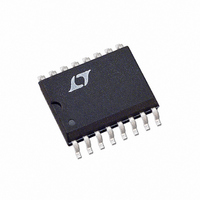LTC1435CS Linear Technology, LTC1435CS Datasheet - Page 14

LTC1435CS
Manufacturer Part Number
LTC1435CS
Description
IC SW REG SYNC STEP-DOWN 16-SOIC
Manufacturer
Linear Technology
Type
Step-Down (Buck)r
Datasheet
1.LTC1435CGPBF.pdf
(20 pages)
Specifications of LTC1435CS
Internal Switch(s)
No
Synchronous Rectifier
Yes
Number Of Outputs
1
Voltage - Output
1.19 ~ 9 V
Current - Output
50mA
Frequency - Switching
125kHz
Voltage - Input
3.5 ~ 30 V
Operating Temperature
0°C ~ 70°C
Mounting Type
Surface Mount
Package / Case
16-SOIC (3.9mm Width)
Lead Free Status / RoHS Status
Contains lead / RoHS non-compliant
Power - Output
-
Available stocks
Company
Part Number
Manufacturer
Quantity
Price
Part Number:
LTC1435CS
Manufacturer:
LT/凌特
Quantity:
20 000
Part Number:
LTC1435CS#PBF
Manufacturer:
LINEAR/凌特
Quantity:
20 000
Part Number:
LTC1435CS8
Manufacturer:
LT/凌特
Quantity:
20 000
LTC1435
4. Transition losses apply only to the topside MOSFET(s),
Checking Transient Response
The regulator loop response can be checked by looking at
the load transient response. Switching regulators take
several cycles to respond to a step in DC (resistive) load
current. When a load step occurs, V
by an amount equal to ( I
effective series resistance of C
charge or discharge C
error signal. The regulator loop then acts to return V
its steady-state value. During this recovery time V
be monitored for overshoot or ringing which would indi-
cate a stability problem. The I
shown in the Figure 1 circuit will provide adequate com-
pensation for most applications.
A second, more severe transient is caused by switching in
loads with large (>1 F) supply bypass capacitors. The
discharged bypass capacitors are effectively put in paral-
lel with C
can deliver enough current to prevent this problem if the
load switch resistance is low and it is driven quickly. The
14
APPLICATIONS
MOSFET and the synchronous MOSFET. If the two
MOSFETs have approximately the same R
the resistance of one MOSFET can simply be summed
with the resistances of L and R
losses. For example, if each R
R
resistance is 0.25 . This results in losses ranging
from 3% to 10% as the output current increases from
0.5A to 2A. I
high output currents.
and only when operating at high input voltages (typi-
cally 20V or greater). Transition losses can be esti-
mated from:
Other losses, including C
losses, Schottky conduction losses during dead-time,
and inductor core losses, generally account for less
than 2% total additional loss.
L
Transition Loss = 2.5 (V
= 0.15 , and R
OUT
, causing a rapid drop in V
2
R losses cause the efficiency to drop at
U
OUT
SENSE
INFORMATION
U
LOAD
which generates a feedback
IN
IN
OUT
and C
= 0.05 , then the total
)(ESR), where ESR is the
)
TH
1.85
. I
OUT
external components
W
(I
SENSE
OUT
LOAD
MAX
DS(ON)
immediately shifts
OUT
ESR dissipative
)(C
also begins to
. No regulator
to obtain I
DS(ON)
RSS
= 0.05 ,
U
)(f)
OUT
OUT
, then
can
2
to
R
only solution is to limit the rise time of the switch drive so
that the load rise time is limited to approximately
(25)(C
rise time, limiting the charging current to about 200mA.
Automotive Considerations:
Plugging into the Cigarette Lighter
As battery-powered devices go mobile, there is a natural
interest in plugging into the cigarette lighter in order to
conserve or even recharge battery packs during operation.
But before you connect, be advised: you are plugging into
the supply from hell. The main battery line in an automo-
bile is the source of a number of nasty potential transients,
including load dump, reverse battery and double battery.
Load dump is the result of a loose battery cable. When the
cable breaks connection, the field collapse in the alternator
can cause a positive spike as high as 60V which takes
several hundred milliseconds to decay. Reverse battery is
just what it says, while double battery is a consequence of
tow truck operators finding that a 24V jump start cranks
cold engines faster than 12V.
The network shown in Figure 7 is the most straightfor-
ward approach to protect a DC/DC converter from the
ravages of an automotive battery line. The series diode
prevents current from flowing during reverse battery,
while the transient suppressor clamps the input voltage
during load dump. Note that the transient suppressor
should not conduct during double battery operation, but
must still clamp the input voltage below breakdown of the
converter. Although the LT1435 has a maximum input
voltage of 36V, most applications will be limited to 30V
by the MOSFET BV
12V
LOAD
Figure 7. Automotive Application Protection
GENERAL INSTRUMENT
). Thus a 10 F capacitor would require a 250 s
TRANSIENT VOLTAGE
50A I PK RATING
SUPPRESSOR
DSS
1.5KA24A
.
V
IN
LTC1435
1435 F07













